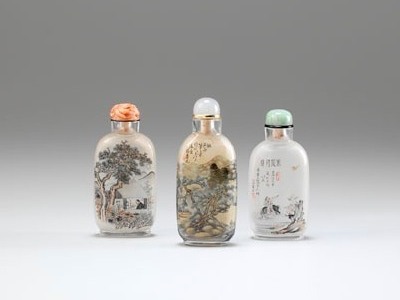
The Chinese Snuff Bottle
Made in every material known to the Chinese—glass, porcelain, jade and other hard stones, ivory, coral, lacquer, amber, wood, etc—the snuff bottle was then produced in enormous quantities and of varying quality to supply the increased demand. Although the high point in the manufacturing of most types of bottles was the 18th century, a great many fine bottles continued to be made throughout the 19th century.
The popularity of snuff and the snuff bottle rose and fell with the Qing Dynasty. After the revolution and the establishment of the Republic in 1912, the fashion of taking snuff died away. Today, however, there are a rapidly growing number of collectors throughout the world who are fascinated by these small, exquisite objects.
Snuff bottles made of crystal or glass (and, more rarely, other materials such as agate or hair crystal) are painted on the inside using a narrow sliver of bamboo or brush, and ink and color. The earliest recorded inside-painted bottles were produced in the early 19th century, and were recorded as being the work of Gan Xuanwen of the Lingnan School in Guangzhou. The proliferation of inside-painted bottles came with the foundation of the Beijing School in the late 1870s by Zhou Leyuan. Another notable artist of that time was Ding Erzhong, whose work was characterized by his delicate brushstrokes and unprolific output. There are also many other notable artists: Ma Shaoxuan, Chen Zhongsan, Wang Xisan, and Liu Shouben, whose works are famous all over the world.
